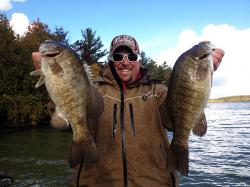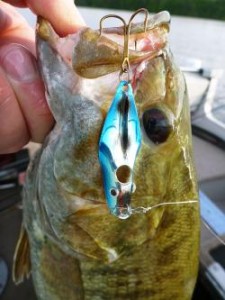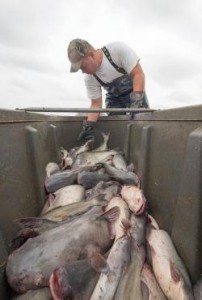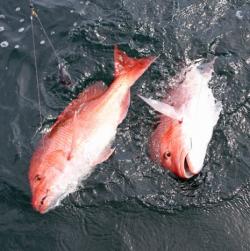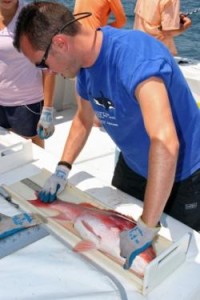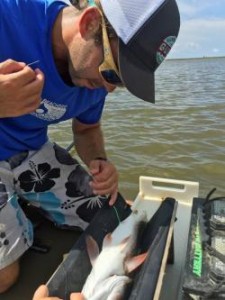Do you find it funny that folks fishing from a boat usually try to cast as close to the bank as possible, while those fishing from the bank usually try to cast as far out in the water as they can? Fishing from a boat definitely gives you some advantages, but so does bank fishing.
Fortunately there are a lot of places where you can fish from the bank near Atlanta. You can drive to them in an hour or so and enjoy good catches. And you have a lot of options for catching bass, from lakes and ponds to rivers and creeks.
Fishing from the bank usually makes you fish slower. There is no pressure to run to another spot to try to catch a fish and leave the ones you could catch if you slowed down and fished carefully. Patience often pays off in better bass catches. You can concentrate on covering a piece of cover carefully and get the bass to bite.
You can fish from the bank much more efficiently if you are willing to wade in shallow water. At times you will need to go around obstacles on the bank by getting into the edge of the water and other times easing out to a couple of feet of water will allow you to reach cover a little too far away from the bank, or to get a better angle on shoreline cover. And fishing streams often requires wading.
Invest in a pair of rubber boots if you don’t like getting your feet wet. You can get a pair that come up almost to your knees for less than $20 and they will really pay off. If you wade in tennis shoes, carry a dry pair of sox and shoes for the ride home.
Keep your tackle simple. A couple of rods and reels, one for casting light finesse type baits and one for casting heavier baits is all you need. On the light outfit spool eight or ten pound line. For heavier baits or fishing thick cover go to fourteen pound test on the other outfit.
A small plastic tackle box that fits in your pocket makes fishing easier. Have some spare hooks and sinkers, a top water plug, a crankbait, a spinnerbait, a few jigs and some plastics. Be able to rig the plastics either weighless on the light outfit or with a one-sixteenths ounce sinker. On the heavier out a three sixteenths to one quarter ounce bullet weight for longer casts and deeper water will work.
The following spots give you several options for catching bass from the shore, so choose one and learn all the cover around it, or try them all.
Lake Lanier
Lanier is a big lake and you might think you can’t cover it without a boat, but go to one of the parks and you can catch fish from the bank. A good one is Buford Dam Park on the south side of the lake right beside the dam.
Both spotted and largemouth bass bed in the pockets in the park on hard bottoms. Sand and gravel are the best bottoms to find bedding fish. Largemouth will bed in more shallow water and further back in the coves than the spots. You can often see the beds or the bass on them.
Cast a worm or lizard into the bed and watch your line for a bite. If you can’t see any beds, drag a Carolina rigged lizard on the sand and gravel bottoms. Move it very slowly to make the fish bite.
Rocks on the dam and in the park are favorite feeding areas. You can cast to the riprap on the dam but be careful walking on the rocks. There is also some riprap in the park to fish. Try a topwater bait, spinnerbait and crankbait over the rocks.
The main lake point past the parking lot is good later in the spring and in the summer as the bass move out to deeper water. A jig and pig or worm works well on the point. Also try fishing from the dock in the park, but bass often hold under it. Walk to the edge of the water near the dock and cast a worm or jig under it in the shade.
Charlie Elliott Wildlife Center/Marben Public Fishing Area
For a good variety of options in one area, drive out I-20 East past Covington to Highway 11, turn south and follow the signs to Charlie Elliott Wildlife Center/Marben PFA. There are 27 different ponds you can fish here but you will need a special license to fish them.
One of the best ponds for largemouth bass is 49 acre Lake Margery. From the shore you can fish the PVC fish attractors, standing timber and brush, riprap and there is a fishing pier, too. The lake is managed to make shoreline fishing easier.
Early in the morning cast a topwater plug over brush and riprap and try the standing timber, too. As the sun gets up work a jig and pig or Texas rigged worm through the brush and timber. In the middle of the day work a crankbait or worm through the standing timber.
Look for bedding bass on this lake, too. And if you can fish the boat ramp without getting into a no fishing area around it, cast a worm to the end of it. Also try the dock on Lake Margery.
If you don’t have good luck on this lake you do have other options to try. Lake Bennett at 69 acres and Lake Fox with 95 acres both offer the same kind of cover and good fishing as Lake Margery.
Sweetwater Creek State Park
Head out I-20 West past I-285 to Exit 44 at Thornton Road and follow the signs. Sweetwater Creek State Park offers a lake to fish, where you can rent a boat if you want to go out on the lake, and a stream that empties into the Chattahoochee River not far from the park. Both the lake and stream offer good fishing.
On the lake don’t hesitate to fish around the heavily used areas where folks like to feed the ducks, if there are not any no-fishing signs. The food for the ducks attracts bream that attract bass. A weighless worm sinking slowly to the bottom is a good pattern to try.
Also try both bridges. There is riprap to fish on both. Try topwater early then switch to a crankbait or spinnerbait. Both the big bridge and the smaller one where Mount Vernon Road crosses the lake and a smaller pocket have a culvert under the road.
Around the culverts try a Texas rigged worm fished near their mouths then cast to deeper water out from the pipe. The culverts mark the channels and bass will often hold on the edge of them so work your worm along the bottom probing for cover.
Sweetwater Creek has shoal, spotted and largemouth bass living in it and they are all fun to catch, but shoal bass and spots will give you the best fight. Shoal bass are not common in most waters so they are usually the targets here. There is a trail along the creek but you will want to wade to catch more fish. Be careful on the slippery rocks.
Shoal bass hold in the deeper pools and can be caught on Texas rigged worms. Rig them behind a one-eighth ounce sinker and cast where the current enters the pool, working your bait with the current. Try the deepest parts of the pool as well as the tail end where the water leaves it.
A small shallow running crawfish colored crankbait is also good. Fish it with the current in the pools. Also try both baits around any rocks breaking the current. Bass often hold behind the rock so cast upstream of it and fish your bait with the current slowly, letting it move at the speed of the current to offer a natural action to the fish.
Fish both baits on light tackle. The bass are not big, with a two pounder a nice fish, but they fight extremely well in the current. Many people say the creek is polluted and will not eat the fish from it, which means more to catch. The state does not list any restrictions on eating fish from Sweetwater Creek but catch and release is the way to go there for safety and the fish population.
Flint River
The Flint River is home of the shoal bass and you can catch a lot of fish, and some quality ones too, in the river. The record shoal bass, an eight pound, three ounce monster, was caught in the Flint River in 1977. They are often called “Flint River Smallmouth” because of the way they look and fight.
Access to the river is limited but the river itself is public waters. The best way to fish the Flint River is to float it in a canoe or small jon boat but there are some places you can drive to and wade the shoals. Sprewell Bluff State Park is a good place to try.
Sprewell Bluff State Park is south west of Thomaston. Take Highway 74 West out of Thomaston, turn left on Old Alabama Road to Sprewell Bluff Road and turn left on it. It dead ends in the park.
Wading is definitely the way to go here. You can cast from the bank but the river is wide and some of the best fishing is upstream of the parking area at the park and you will have to wade to get to it. Be extremely careful on the slippery rocks and the deeper spots. The current can be strong. Wading is best when the river is low.
When you get to the park turn right on the dirt access road going upstream until it ends. If you park there and follow the edge of the river you will come to a big rock bluff and need to wade to get around it. Then start fishing the shoals.
Small baits are best even though you have a good chance of catching a quality shoal bass. Eight or ten pound test line is heavy enough but check your line often since it will get frayed on the rocks.
Shoal bass feed heavily on “rock worms,” the local name for hellgrammites, and a four or six inch black worm imitates them, so it is a good bait. Texas rig it on a one sixteenths ounce sinker and fish it slowly with the current.
Crawfish are another main target of shoal bass so a small, shallow running crawfish colored crankbait is good. Cast it and the worm upstream and work with the current. Target deeper pools and riffs where the current is broken by rocks. The bass hold downstream of the rocks in the eddies created by them.
Topwater baits like a small popper can be excellent for shoal bass, too. Try them in slower moving pools and start with a fast retrieve. If that doesn’t work slow down. Early in the morning and late in the day when shade is on the water is best for topwater, but the bass will hit on top all day long.
You can wade a good ways upstream of the park parking lot and there are excellent shoals to fish. It is not unusual to catch several bass from one rock in a good run, or from a deeper pool. If you catch fish going upstream but sure to hit that same spot coming back downstream.
There is a big deep pool just downstream of the parking lot but past it are more good shoals. The river is split by a big island and both sides of it can be good.
If you don’t have a suitable boat for fishing the river but want to try it, Flint River Outdoor Center at the Highway 36 Bridge will rent you a canoe, take you to Sprewell Bluff and put you in. You can fish back down to the Center where your vehicle is parked.
If you rent a canoe it allows you to fish the deeper water in pools. You an also tie up at the shoals and wade them. Just watch your time, this is a half day trip and it is easy to lose track of time while fishing.
All these spots offer fun fishing from the bank or a boat. Try them all, pick your favorite and you can spend many hours fishing close to the big city.
Good seafood in Thomaston
If you like fresh steamed or boiled seafood, plan your trip to the Flint River on a Thursday, Friday or Saturday. Stop at the Fish Peddler on your way back home for some of the best seafood in the area.
The Fish Peddler is a fish market as well as a restaurant. Their seafood is trucked in each week from the Gulf Coast, so it is always fresh. It looks like a dump, with ramshackle buildings but don’t let that stop you. It is a local favorite and you will be eating in a rustic setting with a lot of folks. And the prices are very reasonable.
Don’t ask for fried seafood, they don’t fry anything. Boiled shrimp and steamed oysters are favorites but they have a variety of Gulf seafood.
The Fish Peddler is on the right side of Highway 19 headed north, just past the bridge over Potato Creek. Watch carefully, it is easy to miss. Look for a bunch of cars around a very rustic building and a small sign identifying the restaurant.

